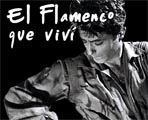Editorial Viceversa 2009
|
A new biographical book reflects the recent history of flamenco and Spanish dance José de la Vega was born in the very flamenco town of Utrera eight decades ago, and from early on knew what his calling would be. He was born to dance, and his intense, successful career has now been documented in the book “El Flamenco que Viví” (‘the flamenco I lived’). Settled many years ago in Barcelona, José de la Vega has been eye-witness and main character in the history and evolution of Spanish dance and flamenco from the mid-twentieth century. Performing artists tend not to have any interest in explaining, much less writing about what they know. For this reason, when a bona fida practitioner of the art picks up his virtual pen to write down a whole life of memories and experiences, it is cause for celebration. Through the pages of “El Flamenco que Viví” dance the names of people like Pastora Imperio, Antonia Mercé «La Argentina», Vicente Escudero, Encarnación López «La Argentinita, Carmen Amaya, Antonio, Rosario, Pilar López, Lola Flores, Farruco, Faíco, Matilde Coral, Emma Maleras, Rosita Segovia, Flora Albaicín, José de Udaeta, Merche Esmeralda, Manuela Vargas, Antonio Gades, Cristina Hoyos, El Güito, Mario Maya, Manuela Carrasco, Antonio Canales and Joaquín Cortés among many others. José de la Vega, winner of Spain’s National Prize for Choreography in 1961, director of his own company, collector of photographs and memorabilia of Vicente Escudero and founder of a prestigious dance school in Barcelona, was trained in the great companies of a dynamic era of the twentieth century. He was first-hand witness to the development of an art-form, and he lays out his knowledge with data, anecdotes and observations with the warmth of immediacy, the rigorous standards of a professional and the guarantee of first person accounts. |
